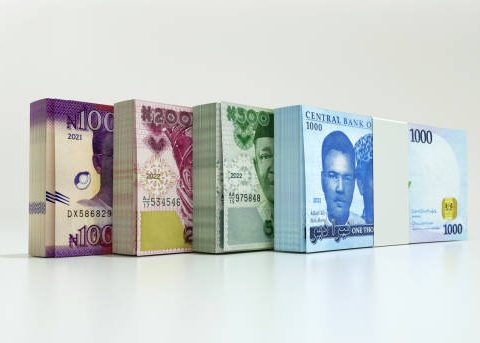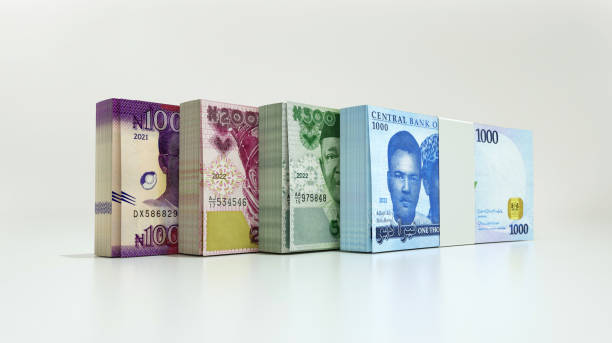The business world has not fully recovered from the devastating effects of Coronavirus (COVID-19) sweeping through Africa and its economies, impacting lives and livelihoods. In this report, Prime Business Africa’s CHIMARA BYGOLD x-rays how Nigeria’s banking system probably emerged stronger, making profits in 2021 and keeping abreast with FinTech disruptions. But this is not the whole story with its heavier flipside, which Prime Business Africa will like to tell in subsequent editions.
WHEN COVID-19 swept through Africa, impacting lives and livelihoods, Nigeria’s banking system was swift to respond.
The Central Bank of Nigeria (CBN) took immediate steps, rolling out stimulus packages to combat the effects of the pandemic on critical sectors, including cutting interest rate on its intervention facilities from nine (9) to five (5) percent.
Join our WhatsApp ChannelThis swift response confirms lessons learnt from the 2016/2017 financial crisis, as the saying goes: “once beaten twice shy?” In simple terms, the Nigerian banking industry was better prepared.
The Proactive measures enabled banks to provide temporary and time-limited restructuring of facilities granted to households and businesses severely affected by COVID-19.
There was a generally cautious approach to lending in the industry, given the difficulties in the operating environment, resulting in negative real loan growth for the year, when the naira devaluation was considered.
Underpinned by the forbearance and proactive measures adopted by banks, the Non-Performing Loans (NPL) ratio, a major challenge for bankers, declined in 2020.
Today, when lenders across the world are barely recovering from effects of lockdowns occasioned by COVID-19, with fears of the now present Omicron, the Monetary Policy Committee (MPC) of the CBN met in November and reassured stakeholders that the sector would remain strong.
The MPC, for instance, noted that the Capital Adequacy Ratio (CAR) and Liquidity Ratio (LR) remained above their prudential limits at 15.2 and 41.2 per cent, respectively.
The Non-Performing Loan ratio (NPL) at 5.3 per cent in October 2021, reflected progressive improvement, compared with 5.7 per cent in October 2020.
The Committee, however, urged the CBN to sustain its tight prudential regime to bring the Non-Performing Loan (NPL) ratio below the 5.0 per cent prudential benchmark.
Keeping Pace With Technology
The advent of technology today is surging through all spheres of life; no doubt, it has revolutionized banking.
Nigeria’s Financial Technology (FinTech) landscape has been recognized as one of the most vibrant in Africa, with FinTech investments growing by 197 percent over the past three years. And this shows little sign of slowing down during and after the crisis, as evidenced by the recent acquisition of Paystack by Silicon Valley group Stripe.
The robust presence of FinTech channels, the active participation of Mobile Money operators, the rapid expansion of the Payment Service Banks (PSBs) and the recent launch of the Central Bank Digital Currency, eNaira, are evidence of a sector undergoing changes to keep pace with global trends.
At present, Nigeria has 32 deposit Money banks, six merchant banks, three non-interest banks and 875 microfinance banks.
The deposit money banks are classified into Tier-1 and Tier-2, based on their financial health – capital adequacy, assets base, shareholders’ funds and reserves strength.
There is also the unwritten Tier-3 or struggling banks operating with weak footholds and hoping for a change in their collective destiny. Such banks are known for their perpetual life support dependency on the CBN borrowing window to remain in business.
A PSB is defined as a category of banks with small-scale operations and the absence of credit risk and foreign exchange operations. They are regarded as a hybrid of conventional banks and fintech companies. They provide banking solutions with the flexibility, accessibility and technology tools employed by FinTech companies in driving the financial inclusion project. Their leverage on technology offers them the unique privilege and capability to provide services that would easily be accessed by the unbanked population and those in areas that are not easy to reach.
On November 4, 2021, the CBN granted Approval in Principle (AIP) to two of the country’s largest mobile telecommunication service operators – MTN Nigeria and Airtel Africa.
The market reacted quickly, with the price of Airtel Africa, for example, rising 21.8per cent from N780/s to N950/s during November. Nigeria has telecom penetration of close to 90.0per cent, so the idea of telecom companies acting as PSBs creates the prospect of significant new sources of revenue. The obvious comparison is with Safaricom in Kenya, which has handled payments for many years.
The AIP prepares ground for the final approval in six months’ time. This will enable them to operate grassroots financial services, especially the Mobile Money channel, which is expected to remove most of the barriers to obtaining bank accounts, such as the Bank Verification Number (BVN) and other KYC (Know-Your-Customer) requirements.
The CBN issued PSB licences to 9Mobile and Globacom in 2020. While 9Mobile has launched its 9PSB in 2020, Globacom licence is still cooling off on the shelf unused. Incidentally 9Mobile’s PSB project did not go far before it ran into murky waters for what experts described as lack of intensity.
Aside from the announced partnership with Fluterwave in September 2020, the 9Mobile PSB project has remained in the silence mode.
With the licences given to MTN and Airtel, any Nigerian who does not have a bank account will most likely be able to ride on the infrastructure of any of the telcos or other service providers to transact through an e-wallet or mobile money account, thereby escaping the hurdles of account opening or maintenance process.
This is expected to take care of the 40 million unbanked adult Nigerians that the eNaira App has excluded in its first phase because they have no access to a bank account, a key requirement of the App.
MTN and Airtel have a combined 124.6 million voice subscribers and 96.1 million data subscribers. MTN Nigeria also has its agent network of 230,000 grown through its MoMo Super Agent platform across the country. Airtel has a legion of airtime resellers which it will plug into to expand its reach. The two network providers are expected to use their PSB operations to create 100,000 jobs for the Nigerian youth. It will also boost the nation’s and states’ revenue base
While Nigeria’s commercial bank branches (per 100,000 adults) in the country was 4.30 as of 2018, mobile phone subscribers per 100 people stood at 99.07. The world average in 2020 based on 144 countries was 113.12 subscribers per 100 persons. Nigeria’s total active bank accounts were about 111.5 million as of September 2020. This is nowhere close to the 205 million active subscriber lines for network operators in the same period.
Nigeria’s largest bank by assets and customer base, Access Bank, has 42 million customers, according to information offered at its H1 ’21 presentation. But MTN Nigeria has nearly over 69 million subscribers in the same period. The MTN disclosed at its nine-month conference that it had increased its agent network by 234,000 agents to about 630,000 agents this year.
First Bank’s agent network, the largest among the deposit money banks, was around 117,000 agents as of H1 ’21.
Mobile phone-led PSB operations have deepened the financial inclusion model in many countries that adopted it. Although Nigeria seems to be coming late to the arena, it will experience rapid expansion as the major telcos enter the ring. Of note is the fact that the value of e-payment transactions in Nigeria rose by 6.37 per cent to N24.08tn in September 2021.
Defying Global Trends
Amidst the tough macro and tight regulatory environment, banks remained resilient, unlike most of their peers across the world. This is evident in Nigerian banks delivering a 15.6per cent and 6.8per cent year on year (y/y) growth in total assets and profit respectively in the first half (H1):2021 despite elevated CRR debits and compulsory Loan to Deposit Ratio (LDR) levels.
The Ike Chioke-led investment banking and advisory firm, Afrinvest (West) Africa Limited in a recent sector report observed that Industry Capital Adequacy Ratio (CAR) improved to 19.4 percent in 2020 relative to 18.7 percent in 2019 (ex. Unity Bank), reflecting the banks’ resilience.
This was higher than the prudential regulatory thresholds of 10.0 percent, 15.0 percent and 16.0 percent for national banks, international banks, and Domestic Systemically Important Banks (D-SIBs).
Reflecting the overall market mood, the banking index at the Nigerian Exchange returned 10.1 percent in 2020. The performance was driven by investors’ interest following impressive earnings and a high dividend yield.
FCMB returned (+80.0 %), Zenith Bank (+33.3 %), and Fidelity Bank (+22.9 %) were the best performing stocks in the sector while Access Bank (-15.5 %t), Union Bank of Nigeria (-10.8 %), Ecobank Transnational Incorporated (ETI) (-7.7 %), and Wema Bank (-6.8 %) lagged.
On inflation, India, China and South Africa held rates at 4.0per cent, 3.9per cent and 3.5per cent respectively. However, in Brazil and Russia, policy rate increased by 75 basis points (bps) and 50bps respectively to 4.3per cent and 5.5per cent in June to tame rising inflation levels.
Nigeria’s inflation rate fell for the seventh consecutive month in October to 15.99 percent which is still high, from 16.63 per cent recorded a month earlier.
Interestingly, the CBN has for many years, now set an inflation target of 6.0per cent – 9.0per cent as one of the benchmarks to achieving its first objective – Monetary and Price stability.
Sadly, this goal has remained elusive in the last six years due to conflicting and counterproductive policy measures.
Although inflation rate eased in all the five months to August 2021 (to print at 17.0%) due to high base-year support, Foreign investors’ apathy towards Nigeria continued in H1:2021. Total foreign capital flows stood at US$2.8billion, which translates to a 61.1per cent y/y decline compared to H1:2020 (US$7.1bn).
Meanwhile, the county’s average inflation rate for 1999 – 2020 period was approximately 12.1per cent, whilst US, UK and Europe all have an average inflation rate of sub 2.5per cent for the same period.
Inflation differential is the difference between inflation rate in Nigeria versus inflation rate in other countries.
For the Naira, the inflation rate differential is almost double digits against major currencies such as the United States (USD), UK (GBP) and EUR).
Nigeria’s average inflation rate suggests an inflation differential of between 9per percent to 10per percent.
Experts have reasoned that this near double-digit inflation differential means that over time from a Naira perspective, Nigerians will always need more money to buy the same foreign goods (all things being equal as the Economists would say).
Using Naira’s inflation differential of approximately 9.5per cent,suggests that if N100 bought USD$1.00 worth of goods in 2000, over a 20-year time about N614 would be needed to buy the same worth of goods by 2021 end.
That is 100 compounded at 9.5per cent over 20 years.
Naira’s nominal exchange rate actually moved from the low N100s/$1 in December 2000 to its current state of about N560/USD$1 as of November 2021.
The situation continues taking an immense toll on both individual purchasing power and business capacity to flourish.
This is the environment Nigerian banks find themselves in, yet they are forced to lend to the productive sectors or have part of their deposits quarantined by the regulator.
The worse the inflation differential becomes, the higher the risk of currency depreciating faster, but the Federal Government through the CBN is doing everything possible to defend the naira including directing the banks to publish names of customers who engage in exchange rate malpractices.
Specifically, against the major currencies, (USD, GBP, JPY, EUR), the long-run relationship between the Naira and these currencies is a linear depreciating relationship.
The irony is that despite all these, the banks are said to be strong and resilient as well as making profits.
Another aspect that requires a mention is the advent of blockchain technology.
This has led to the unlocking of highly sought-after financial solutions and assets that were not envisaged a decade ago. It has led to the swift adoption and rise to prominence of cryptocurrencies such as Bitcoin and Stable coins.
In Nigeria, the CBN banned banks from facilitating transactions for Cryptocurrency exchanges.
According to data obtained from Atlantic Council, about 81 countries, representing over 90.0 per cent of global GDP, are currently exploring the CBDC option. Out of which, only five countries including Nigeria have fully launched their CBDCs, while the rest are either in Pilot (14), Development (16), Research (32), Inactive (10), or Other (4) phases.
Arguably, central banks around the world are looking to add the CBDC to their currency gallery and the commercial banks are expected to serve as the primary distribution channels.
The trend in 2020 was a “flight-to-safety” by foreign investors as the spill-over effect from the pandemic weakened Nigeria’s macro-fundamentals including the interest and exchange rates. Besides, the inability of portfolio investors to repatriate over US$2.0billion in Q2:2020 due to FX liquidity management by the CBN played a part in the contraction, as investors developed apathy for the Nigerian market.
Half Year/ Q3 2021
The banking sector recorded mixed financial performance for the first half 2021, H1’21. Prime Business Africa’s findings from the financial results of 14 leading banks listed on the Nigerian Exchange Limited (NGX), shows that the combined gross earnings grew marginally by 2.9 per cent to N2.463 trillion from N2.399 trillion recorded in the corresponding period of 2020, H1 ’20.
Reacting, Ayodeji Ebo, Head, Retail Investment, Chapel Hill Denham, said: “Financial performance of the banks in H1:2021 has been mixed with more positive outings by the Tier-1 banks that control over 70 per cent of business activities in the sector.
“We saw improvement in impairment charges attributed to pick up of business activities in the economy as well as rise in global crude oil prices. We expect the positive trend should be sustained.
“However, OPEX (Operating expenditure) is expected to rise due to higher cost of doing business. We expect an adjustment in FX to be positive for most of the Tier-1 banks which is likely before the end of the year.”
Similarly, in the area of growth in Assets, despite the prevailing harsh economic climate, eight of the Deposit Money Banks (DMBs) in the country grew their total assets by 10.08 per cent.
The lenders’ nine Months (9M) 2021 unaudited financial statements show that their combined assets berthed at N39.58trillion from N35.95 trillion at the end of December 2020.
The DMBs are, Zenith Bank, Access Bank, Guaranty Trust Holding Company (GTCO), United Bank for Africa (UBA), Union Bank, Stanbic IBTC, Wema Bank and Unity Bank.
Analysis of the lenders’ September 2021 unaudited financial statements, shows that Access Bank maintains its position as the largest bank in the country in terms of assets, as its unaudited results for the period ended 30 September 2021, put its total assets at N10.37 trillion, compared with assets of N8.68 trillion that the Tier 1 bank reported in its FY’ 2020 financial statements.
It was followed by Zenith Bank with total assets of N8.75trillion as at the end of September 2021 as against the N8.48 trillion the lender posted for FY’ 2020.
Also, UBA’s unaudited results for Q3 2021, show that the lender’s total assets increased by 8.70 per cent to N8.35 trillion from N7.69 trillion at the end of last year.
In the same way, another Tier 1 lender, GTCO, reports in its September 2021 unaudited financial statements that total assets increased by 4.03 per cent to N5.14 trillion from N4.94 trillion at the end of 2020.
For the Tier 2 lenders, Stanbic IBTC leads the pack as its unaudited financial statements for the nine months ended September 30, 2021, show that total assets increased to N2.75trillion in the first nine months of this year from N2.49trillion at the end of last year.
It was followed by Union Bank with total assets of N2.56trillion as at the end of September 2021 compared with N2.19 trillion that the lender posted for FY’ 2020.
Wema Bank’s unaudited financial statements for the nine months ended September 30, 2021, indicate that the lender’s total assets grew by 10.7per cent in the first nine months of this year to N1.08trillion as against N979.5billion at the end of 2020.
Equally, Unity Bank reported in its September 2021 unaudited financial statements that total assets increased by 17 per cent to N574.56billion from N492.02billion at the end of last year.
Analysts note that Nigeria’s banking industry total assets have been on an upward trajectory in recent years despite the challenges of a tough business environment.
Data obtained from the Central Bank of Nigeria (CBN), for instance, shows that DMBs’ total assets and liabilities, which stood at N34.59 trillion at the end of December 2017, rose to N37.21 trillion at the end of December 2018 and further increased from N38.57 trillion in November 2019 to N42.89 trillion in February 2020.
Indeed, the banks’ asset growth trajectory has not been reversed even though in June last year, Fitch Solutions Group (FSG)-an affiliate of Fitch Ratings Incorporated- citing Covid-19 -induced economic headwinds, revised its forecast for Nigeria’s total banking asset growth to 5.3per cent to N44.2trillion in 2020.
Personal statements made by members of the CBN’s Monetary Policy Committee (MPC) in September, which were released by the apex bank recently, show that they expressed satisfaction regarding the health of the country’s banking industry.
For instance, in his personal statement, Deputy Governor in charge of economic policy at the CBN, Dr. Kingsley Obiora, said: “The financial soundness indicators showed that the banking system remains sound, stable and resilient. The total assets of the industry increased by 15.38 per cent from N47.58 trillion in July 2020 to N54.90 trillion in July 2021. Consequently, the gross banking sector credit increased by N6.63 trillion from N15.57 trillion at the end of December 2020 to N22.20 trillion at the end of July 2021.”
Challenges, Opportunities
A recent report by Mackenzie noted that profitability is being dampened by the Cash Reserve Requirement (CRR), which, at 27.5 percent, is among the highest in the world.
The CRR requires banks to park an increasing amount of local-currency deposits with the central bank, and restricts their ability to lend as these reserves are only available for intervention funds.
Experts suggest that as competitive intensity rises and margins come under increasing pressure, gaining a cost advantage becomes imperative. Scale can help bring down marginal costs as a bank gains operating leverage with a consistent increase in size.
However, Mackenzi analysis shows that it is not total size across the diverse markets a bank serves that enables superior performance, but optimal scale within a given geography or segment.
The total banking industry assets will hit N71.1 trillion in 2022 after rising 8.2 percent year on year to N65.1 trillion in 2021, 2021 banking industry report recently published by Afrinvest (West) Africa projects.
The report said the Tier-1 lenders will own 62.6 percent of the total industry assets, while the lower tier financial institutions will account for just 37.4 percent of the total in 2021; and 63 percent and 27 percent, respectively, for next year.
Afrinvest expects the industry’s total loans to hit N27.5 trillion next year after reaching N24.9 trillion by the close of 2021.
But, in terms of asset creation, as contained in the report, the banks grew their loan books by 16.3 per cent year on year to N24.6 trillion from N21.2 trillion in 2019, supported by a surge in deposits of 28.4 percent year on year within the same period, as banks aimed to achieve the CBN’s LDR target (65.0%).
In Nigeria, significant opportunities remain for banks to develop scale across segments—for example by targeting small and medium-sized enterprises (SMEs), which have significant unmet needs in the banking sector—or by targeting geographies such as the north of the country, which has been historically underserved.
Whichever geography or segment they choose to play in, banks can look for new ways to leverage digital to serve customers at scale.
The unprecedented scale of the COVID-19 crisis has forced banks—and indeed all members of society—to reexamine and reimagine the way they do things.
The McKinsey Financial Insight Pulse survey conducted in October 2020 found that most consumers expect to increase their use of digital and mobile banking services even after the crisis, with 53 percent of consumers wanting their banks to make it easy to get a line of credit and 36 percent desiring improved bank websites to facilitate online transactions.
Now is an opportune moment for banks to revisit and interrogate matters of efficiency and productivity in a disciplined manner. Actions taken out of necessity during the lockdown such as online training, virtual performance management sessions, remote working for certain jobs, and adjusted operating hours for branches could be refined for implementation on a permanent basis.
“Our analysis shows there is a 25 to 40 percent cost-reduction opportunity for Nigerian Banks—primarily to be found in revisiting the branch network and coverage model, increasing efficiency of spend, and increasing productivity through end-to-end digitization,” experts from McKenzie suggested
Spend-control towers could be set up to review every spend request above a certain threshold, with the aim of not just addressing immediate efficiencies but bringing to light opportunities that need to be addressed given new models of working. This could include, for example, reviewing vendor agreements for cash management based on adjusted operating times and hours for branches or adjusting expansion plans in light of physical-distancing requirements and remote-working options.
Beyond spend control, banks could accelerate end-to-end digitization to capitalize on consumer’s newfound willingness to use electronic channels. While most banks have digital options in place and have made progress in driving channel migration during the past few months, the high footfall into branches post-lockdown suggests there are still gaps.
McKinsey says rethinking end-to-end digital options for card subscription and renewal, PIN reset, and electronic channel issue resolution, to name a few, could unlock new growth.
In addition, sales and lending processes, which have been heavily reliant on physical interaction, could be reviewed to identify automation potential, especially for SMEs. Ultimately, reimagining these processes in line with consumer requirements will lead to a redefinition of the role (and size) of the branch network and required coverage model.
Previous McKenzie research has demonstrated that data and analytics can potentially increase a bank’s cost advantage by 10 percent and improve cost-to-income ratios by up to 15 percent, even in a recession. Two immediate areas to explore are risk and sales, particularly digital marketing.
“Nigerian banks could develop new risk models powered by artificial intelligence and machine learning that improve accuracy and efficiency and leverage real-time transaction data to understand market and customer dynamics.
“This could help them to explore opportunities in new segments and ramp up effective and personalized customer service, as well as to meet regulatory requirements,” the firms report read in part.
McKinsey research has repeatedly demonstrated that diverse companies are more likely to outperform those that lack diversity and that more inclusive work environments produce better results and enhance the employee value proposition.
Furthermore, for financially strong Tier 1 banks with scale (resilient and market leaders), now is the time to consider investing in technology infrastructure and talent to expand beyond current customers and products. Equipping employees with the right skills and digital tools, doubling down on digital marketing, and establishing robust digital infrastructure are likely to be key enablers for success in the next normal.
It also recommends that given the current environment, banks with stable balance sheets could selectively explore mergers and acquisitions, partnerships, and joint ventures across the financial services landscape that could help achieve scale and acquire new talent and customers.
Tier 2 banks, faced with smaller balance sheets and less room to manoeuvre (follower and challenged), could focus on differentiation.
“Our research has shown that banks serving a niche segment with a specialized product suite and superior customer service have managed to sustain high-return premiums irrespective of size. “Driving productivity by, for example, expanding shared utilities and infrastructure is also important. However, for banks that are subscale with significant challenges with their loan books and capital structure, the urgency is acute, and some may wish to consider selling to a stronger buyer with a complementary footprint or portfolio of services.
Five key factors for next wave of transformation
The duo of Eyitope Kola-Oyeneyin and Mayowa Kuyoro are both partners in McKinsey’s Lagos office. They highlighted five key factors to watch to usher in the next wave of transformation in the banking industry.
According to them, the five key factors, and the interplay among them, will be pivotal in determining how the sector evolves.
First, Nigeria’s CRR ratio increased by 5 percent to 27.5 percent in January 2020 but the actual effective rate is estimated to be above 50 percent.
Under current regulations, Nigerian banks can request to access deposit monies at specified rates to provide credit financing for development projects in the real sector (agriculture and manufacturing), but it remains to be seen if they can utilize this effectively. This perceived “fiscalization’’ of banking has led Fitch Ratings to downgrade Nigeria’s banking sector from stable to negative.
While the regulator’s recent introduction of special bills is expected to improve liquidity in the system, banks will need to be proactive in this environment by taking steps within their immediate control including:
1) developing capabilities to identify and fund viable businesses within the intervention fund category;
2) restructuring their funding base to reflect the realities of the current CRR impact;
3) Using this opportunity to educate the frontline (and harmonize targets across the organization) on the implications of CRR and the effective cost of every deposit.
Second, to thrive beyond the crisis, Nigerian banks will need to bolster their capital levels and grow capital faster than the rates of inflation and devaluation. This will be no small feat in the current environment. Given the need to meet Basel III requirements, the possible deterioration of asset quality, and some foreign-exchange-based commitments to service, it is likely that another round of consolidation and capital raising is approaching.
Three lessons from previous consolidations emerge for consideration in the next round
First, strong Tier 1 banks benefited most—big banks got bigger, benefiting from scale, flight to safety, and possibly limited distraction from acquisitions. Second, only bold, at-scale combinations were rewarded, with only one combination resulting in a Tier 1 contender. And third, banks that did nothing or too little got pressurized in an increasingly concentrated market.
The third factor is that with around $15 billion of bad loans still owed by the Asset Management Corporation of Nigeria (AMCON) to the CBN from the last financial crisis, the Nigerian economy can ill afford another portfolio crisis.
However, there is a very real risk that in the current economic environment—with the 65 percent loan-to-deposit ratio requirement, low-interest rate intervention fund loans, and challenges with risk management practices in many banks—that this may occur. There are risks to consider with restructured intervention loans strategy, notably, how many of these restructured loans are really viable? How many nonperforming loans will be created in this environment through intervention funds? And what portion of the industry trade book is at risk due to devaluation? These are indicators that will need to be monitored on an ongoing basis.
The fourth is regulatory collaboration: Streamlining regulation to support innovation and diversification.
McKinsey believes that as banks seek to mitigate the negative impact of the crisis on their revenue streams by diversifying into new and adjacent financial-services businesses, the synchronized perspective of key industry regulators, including the CBN, the National Pension Commission, the National Insurance Commission, and the Ministry of Finance, will become increasingly critical to unlock broad-based financial services growth and true financial inclusion.
A number of banks have already announced plans to expand their financial services portfolios. Seeing how well these banks fare in delivering diversified financial services will be a key factor to watch going forward.
The fifth factor according to McKinsey is that banking sector infrastructure requires continue d improvement.
The Nigeria Interbank Settlement System (NIBSS), which is jointly owned by the CBN and all licensed banks, has played a critical role in the Nigerian banking industry over the past three decades—putting in place effective shared infrastructure to facilitate interbank payments. Today, NIBSS and privately-owned Interswitch power Nigeria’s payment ecosystem. Given the essential nature of electronic services, this infrastructure requires continuous improvement and expansion. In addition, there is scope for the industry to come together to build on this foundation, enabling the next wave of shared services. Specifically, the sector can leverage payments data—including a Bank Verification Number (BVN) database of over 43 million—and other nontraditional sources of data to build new credit algorithms that can unlock lending for SMEs and other underserved segments.
Together with the recent Global Standing Instruction policy, this could be the critical enabler for credit growth in Nigeria’s deposit-rich and asset-poor banking industry.
” With banking revenues projected to return to pre-crisis levels only between 2022 and 2024, depending on whether a rapid or slow recovery scenario prevails, Nigeria’s banking sector faces a prolonged period of uncertainty.
“This is yet another wake-up call. The shape and the resilience of the industry post-pandemic will depend on how stakeholders respond now. It’s time for bold choices and decisive execution—the faster the better,” the firm concluded.
















Follow Us